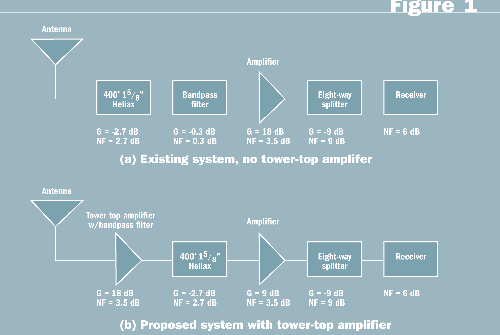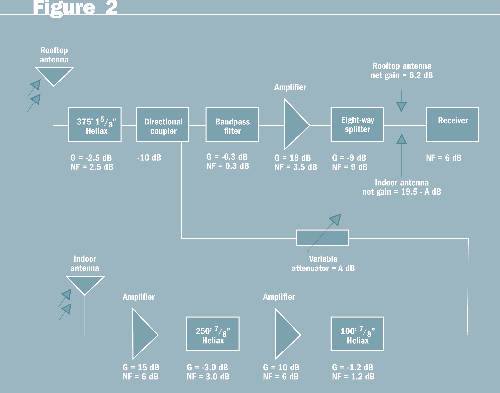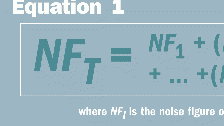Tower-top amplifiers and noise figure (part 1 of 2)
The purpose of a tower-top amplifier, or TTA, is to improve receiver sensitivity at the repeater site. Good sensitivity at the repeater is especially important in land mobile radio systems because it overcomes some of the link imbalance created by the high-power repeater transmitter.
TTAs are most effective in noise-limited environments where uplink (reverse link, talk-back) interference levels are negligible. The TTA offers no improvement in carrier-to-interference ratio (C/I), only carrier-to-noise ratio (C/N). Interference is amplified decibel for decibel, just as the carrier signal is amplified.
Unfortunately, many 800 MHz urban sites are subject to high interference levels. This interference comes from a variety of sources, including other two-way radios, enhanced specialized mobile radios, bidirectional amplifier donor antennas and cell phones. Note we are referring to interference originating external to the repeater or cell site but captured by the receive antenna. It is generally not under your control. However, co-site interference is under your control and should be corrected.
TTAs add expense and complexity to the system, and they generally increase the likelihood of receiver overload, so they should only be used when some real benefit is derived. The purpose of this two-part article is to define the conditions under which a tower-top amplifier actually improves receiver sensitivity and thereby offers some benefit. This month, we will examine the classic noise-limited case. Next month, we will investigate the interference-limited case.
Let’s start with a refresher on noise figure. The noise figure, NF, of an amplifier is the ratio of the input C/N to the output C/N, or NF=(C/N)i/(C/N)o. The smaller the noise figure, the better. A perfect noise figure (not achievable in practice) is NF=1, or 0 dB.
Typically, the noise figure of interest is the composite noise figure, equal to the equivalent noise figure resulting from several cascaded elements such as cables, amplifiers and power splitters. The composite noise figure of n cascaded elements is represented in Equation 1.
All terms in Equation 1 are ratios, not decibels. Note that the gain of the nth element (usually the receiver) does not enter into the equation. From Equation 1, we see that a low composite noise figure is achieved by installing a low-noise, high-gain amplifier near the antenna. If the system gain is kept high downstream, the composite noise figure is determined primarily by the noise figure of the TTA. Noisy amplifiers that follow, including the receiver front-end, will have negligible effect.

Now let’s consider a hypothetical example of a five-channel 800 MHz trunked radio system. The receive antenna is located on a tower 350 feet above ground, and there is a 50-foot coaxial cable that runs from the tower to the repeater. The existing system does not employ a TTA, and the system manager wants to know if a TTA will improve the talk-back range. Figure 1 below shows the system block diagrams for the existing and proposed systems.
Note that the gain in the receiver multicoupler amplifier is 9 dB when the TTA is used and 18 dB when there is no tower-top amplifier. However, the net gain with the tower-top amplifier is still higher; therefore, the system with the tower-top amplifier is more vulnerable to overload at the receiver.

By applying Equation 1 to the two configurations shown in Figure 1, we find that the composite noise figure without the tower-top amplifier is 7.4 dB and the composite noise figure with the tower-top amplifier is 3.8 dB. In other words, the noise figure — and therefore receiver sensitivity — is improved by a factor of 3.6 dB (7.4 dB-3.8 dB).
Consider a second hypothetical example illustrating the effect of a distributed antenna system (DAS) on system noise figure. In this case, Giant Pacific Telephone Company (GPTC), an 800 MHz wireless provider, is installing a cell site on the roof of the city convention center. One of the rooftop sectors also will provide service inside the convention center’s below-grade auditorium where the rooftop sector cannot penetrate. The auditorium will be served by a DAS. A block diagram of the installed configuration is shown in Figure 2.

We notice that GPTC does not use tower-top amplifiers in urban areas because its network is interference-limited, not noise-limited. GPTC also knows that the amplified DAS has the potential to desensitize the base station receiver, so it installed a variable attenuator to attenuate amplified noise on the reverse link of the DAS.
All of the company’s engineers are on vacation this August, so GPTC has hired us to do the following:
-
Calculate the composite noise figure of the isolated rooftop system.
-
Calculate the composite noise figure of the isolated DAS with A=0 dB.
-
Determine the required value of attenuation, A, in decibels.
-
Re-calculate the noise figure for the DAS with this value of attenuation.
Let’s do the easy tasks first. Using Equation 1, we find that the composite noise figure of the rooftop system in isolation is 7.2 dB. The composite noise figure of the DAS in isolation, with the variable attenuator set to 0 dB, is 6.5 dB.
To determine the required value of attenuation, A, let’s first assume that a 0.5 dB degradation in sensitivity of the rooftop sector is acceptable. This maximum desense requires that the amplified noise from the DAS be at least 9 dB (factor of 8) below the noise floor of the receiver (i.e., 10log10(1.125)=0.5 dB). From Figure 2, we see that the rooftop antenna system has a net gain of 6.2 dB versus 19.5-A dB for the DAS. Thus, with the attenuator set to 0 dB, the DAS has a much higher amplified noise floor at the receiver, and it will severely desense the rooftop antenna system.
An approximate solution to this problem is to simply set the attenuator so the net gain is 9 dB lower than the rooftop system, resulting in A=22.3 dB. Applying Equation 1 with this value of attenuation, we find that the noise figure for the isolated DAS is now 16.3 dB.
We’re not done yet. The DAS does not operate in isolation. Now that its signal is 9 dB weaker than the rooftop system, it is further desensed by the amplified noise on the rooftop system. In other words, the two noise sources combine inside the receiver and worsen the noise figure of the DAS.
When two noise signals are added in a device with unequal gains, one can show that the incremental noise figure of the weaker signal is equal to gs/gw+1 where gs is the gain of the stronger signal and gw is the gain of the weaker signal. In our case, the two gains differ by a factor of 8, so the incremental noise figure is 9 or 9.5 dB. Our composite noise figure is now 16.3+9.5=25.8 dB.
Thus, to protect the rooftop antenna system from desense, we have lost 19.3 dB of sensitivity on the DAS and a corresponding loss of reverse link coverage on the indoor system.
What lessons have we learned? Reverse link performance of the DAS can be severely degraded if the DAS and the rooftop sector must share the same receiver. A better approach is to dedicate a sector radio to the DAS. For land mobile radio systems, the solution is to use a voting receiver and select the best signal (rooftop or DAS) from the demodulated baseband signal.
Next month: Tower-top amplifiers and interference.
Jay Jacobsmeyer is president of Pericle Communications Co., a consulting engineering firm located in Colorado Springs, Colo. He holds bachelor’s and master’s degrees in electrical engineering from Virginia Tech and Cornell University, respectively, and has more than 20 years experience as a radio frequency engineer.

















